#oak gall
Text

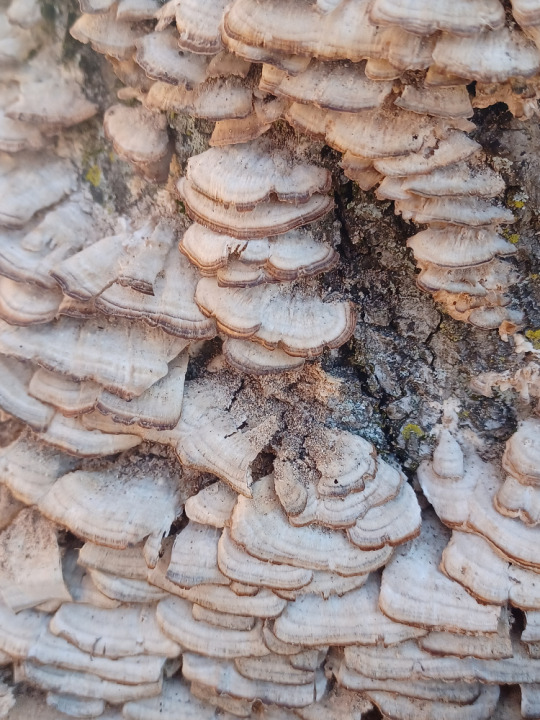
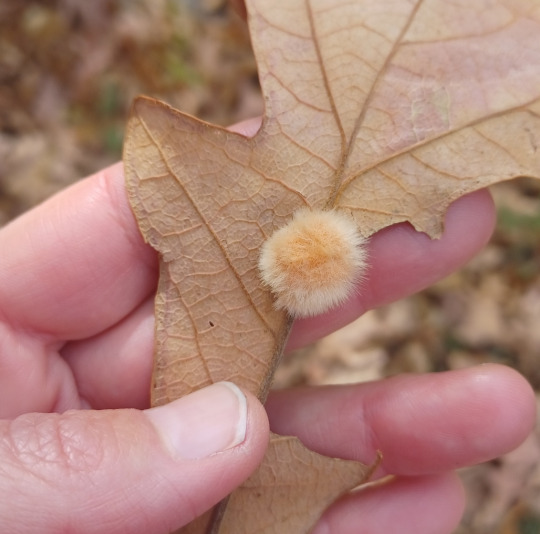
Well, it's been a whirlwind few days! Thursday I went on the weekly phenology walk at Audubon Trails Nature Center in Rolla, MO. It's the last one of the year, and we were seeing if there were still any wildflowers in bloom in spite of the freeze a few nights before. We did find a scant few Asteraceae with open flowers, but for the most part everything was done for the year. It was a really good experience getting to wander the trails with someone who knows the local flora really well; I'm still playing catch-up on learning (and remembering) native prairie plants in this area, and since they happen every Thursday morning during the growing season, I'm going to make sure and attend whenever I'm in town.
Thursday afternoon I officially taught my first in-person class in Rolla with my basic mushroom foraging intro at the Rolla Public Library. I checked out SO MANY BOOKS from that library as a kid, and so it was basically coming full circle to be able to teach there. I had an awesome audience that packed the room, got some great questions, and really appreciated the support that library staff gave me throughout the entire process. I'm already brainstorming what I want to teach when I head back to this area next spring.
Friday I got to spend immersed in planty goodness at the Missouri Botanical Symposium. I had actually registered last year but ended up not feeling good at the last moment so I had to miss out. Totally worth the entire trip this year, though! There were some really great talks (I especially enjoyed the one on the interplay of geology and plant life in Missouri karst fens), and I even made some good connections and new friends! I am SUCH an introvert that it can be tough for me to go around introducing myself in a room where I don't know anyone, but luckily a friendly extrovert latched onto me and helped me meet some really cool people. (Also, pro tip: having art supplies out and in use makes for a great conversation starter, and if you bring enough for others to use you can have a little science illustration party at your table!)
Saturday I peeled myself out of bed early yet again for a very good reason--I got to lead a lichen hike at Audubon Trails! It sort of felt like cramming for a test because while the basic biology of lichens is the same everywhere, I'm not as familiar with local species here as I am back home in the PNW. So I visited the site a few times on this visit to look for cool lichens and try to get them down to at least a genus level, if not species. Again, really great turnout for the hike--people were having a great time, lots of excellent questions and discoveries along the way. And there were two kids from the Rolla Outdoor Collaborative School on site who were not only THE best guides to the trails there, but they found and showed off some cool stuff (including lichens, AND fuzzy oak galls!) The next generation of naturalists is already well on their way to helping others connect with the great outdoors, which does my heart good.
I gotta start driving back west tomorrow; I have classes in Portland next weekend. So today is being lazy, doing laundry, and helping my folks with a few more things around the house. It's been another great visit here, though, and I'm already making plans for next year. I'm going to try to schedule a couple of classes along the way for my spring trip; since I'll likely be taking I-70 since 80 is sketchy even in April, I'm probably looking at Salt Lake City and Denver for venues. I'm open to suggestions if anyone knows of a bookstore, library, nature center, or similar who might like to host a wandering naturalist infodumping about ecology for a couple of hours!
#Missouri#Ozarks#nature#naturalist#mushrooms#fungi#mushroom hunting#prairie#tallgrass prairie#oak gall#gall wasps#oak#oak trees#ecology#plants#botany
19 notes
·
View notes
Text
youtube
If you are lucky enough to find oak galls while foraging, grab a handful for your dye pot! The oak gall is full of tannin and is a great way to pretreat your textiles, especially plant (cellulose) fibers like cotton, linen, bamboo and hemp, to create stronger color bonds with natural dyes. The 'mordant' process is an extra, but important, step to help organic color last longer and protect it from fading with exposure to light and wash. Oak galls are a great option because they leave very little color on the fiber, but pack a tannin punch. You can also create beautiful grays using an iron water modifier with oak gall tannin. This video tutorial will show you how to treat fiber with oak gall tannin as a mordant, test it with hibiscus dye and shift colors to a full spectrum of light and bluish grays with iron. We will also test oak gall and hibiscus dye on wooden beads to add color to earthy handmade jewelry.
CHAPTERS
0:00 Introduction - Oak gall
2:11 Oak gall tannin mordant
3:55 Tannin + iron
5:08 What exactly is an oak gall?
6:10 Tutorial highlights
7:25 How to make an oak gall tannin mordant - cold & hot soak
9:21 How to make hibiscus dye
9:49 How to dye wooden beads - oak gall tannin, hibiscus & iron
12:34 How shift color with iron water
14:04 Fiber swatch & wooden bead results
15:58 Recap
20:41 Sneak peek of next tutorial
21:34 Blooper
SUPPLY LIST
Oak gall - whole or ground
Hibiscus flowers - dried
Iron powder and/or homemade iron rust water
Gloves
Mortar & pestle
Pot with lid
Measuring cup
Measuring spoon
Strainer
Spoon
Bowl
Scale
Glass jars
Fiber
Wooden beads
#Margaret Byrd: Color Quest#solarpunk#dye#natural dye#how to#how to dye#diy#do it yourself#oak galls#Oak gall#tannin#textile#fabrics#hibiscus#wooden beads#Youtube
5 notes
·
View notes
Text

I have suffered so much trying to figure out why the fuck these oak galls are Like This, because I’m familiar with oak galls and they don’t look like squidgy mangoes. Turns out the Oregon white oak, a tree with a very limited range, just does this I guess? Even knowing what I know now I still want to bite it, my brain is convinced I have discovered a brand new kind of fig.
#oak gall#i'm so glad oak gall is a popular tag#absolutely wild about tree folks who blog about trees#sorry for the bad pic#i was walking the pup and she hates it when i take pictures#and when i don't let her dive into the duck pond#so she's had a rough day
2 notes
·
View notes
Photo

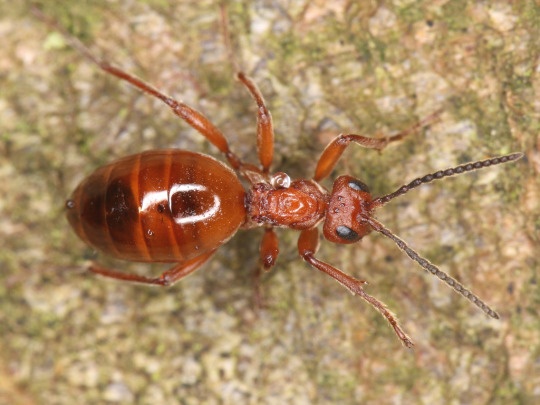
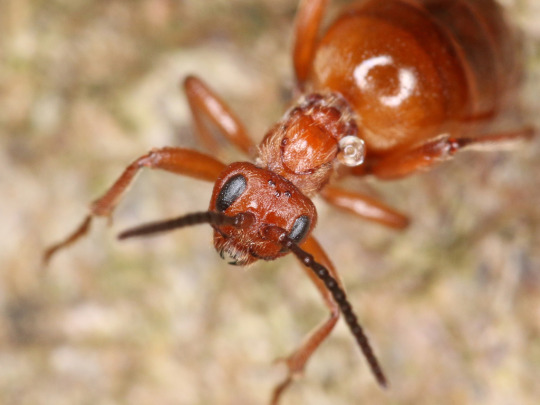
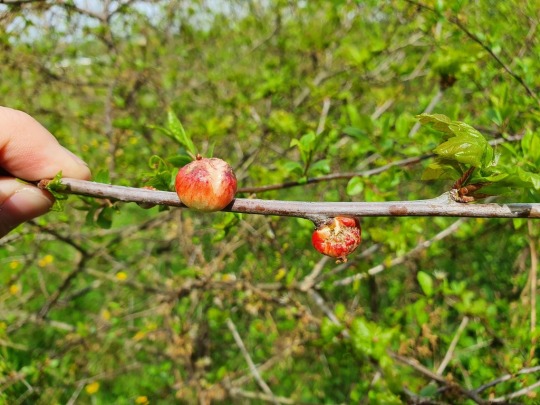

Oak apple gall wasp, Biorhiza pallida, Cynipidae, Hymenoptera
Pictured is a female oak apple gall wasp and the apple-like galls that form around her larvae in oak trees. This species is found throughout Europe. In addition to feeding and sheltering the oak apple gall wasp larvae, the galls house several other species of gall wasp and at least 20 species of hyperparasitoids that feed on the larvae.
Photos 1-3 by zmrdk, 4 by bclunie, and 5 by cedzz
#animals#curators on tumblr#insects#bugs#wasp#gall wasp#gall#oak apple gall wasp#one nice bug#dang it's crowded in those galls#also she is thick and beautiful wow
328 notes
·
View notes
Text
The Glorious Complexity and Mysteries of Galls, Wasps, Ants, and Aphids
Plant galls are structures of plant tissue that grow in response to the actions of arthropods, bacteria or fungi. These living things hijack the plant and "make" it grow something they find useful.

An "oak apple" type gall created by a parasitic wasp by laying an egg in the leaf as it was growing.
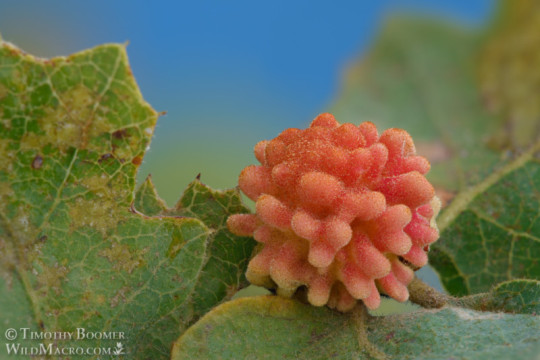
The shapes and structures of galls vary wildly, and often have no obvious correspondence to any of the other parts of the plant. (If you you have a strong trypophobia response be careful googling images of galls some make my crawl, others are etherial)

Some galls seem to be optimized to foil parasitoids who try to lay their eggs inside the pupae of other insects. A wasp would need a very long ovipositor to get to this larva suspended in the center! Somehow the wasp egg induces the tree to grow this complex structure! Amazing!

Although ants are closely related to wasps who play a large roll in the formation of plant galls, ants are *normally* only secondary fauna of galls and not gallmakers.

This is surprising to me since so many plants roll out a welcome mat for ants: extrafloral nectaries as cafeterias, hollow stems& thorns as dormitories. A resident colony of ants can be a plants personal private security detail.
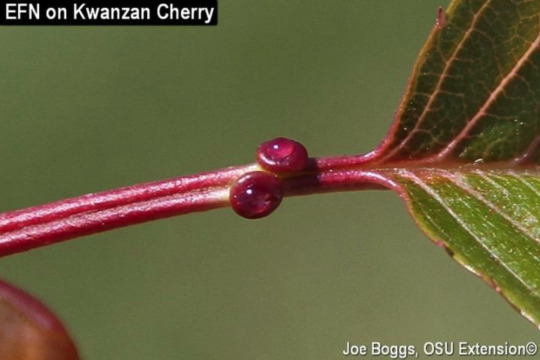

For all the many symbiotic parings of ants and plants there are only a few ants that induce their own galls. As secondary fauna of galls (often created by their creepy cousins, the parasitoid wasps) ants may also act as pest control.
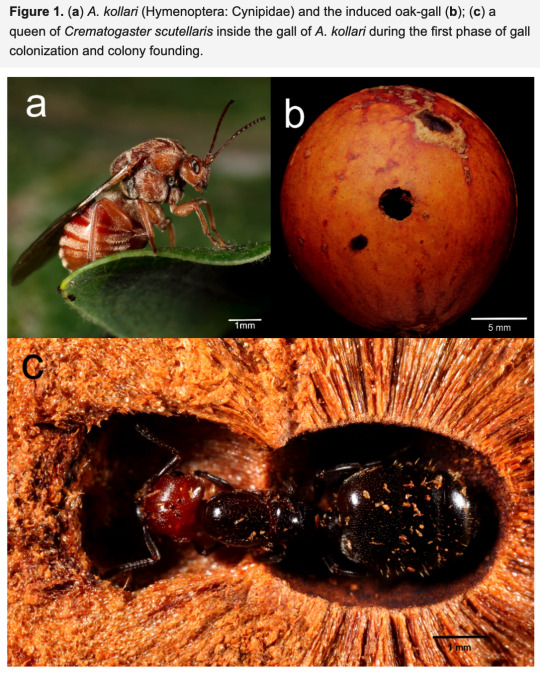
This raises the question: Could plants "allow" gall wasps to make these otherwise energy intensive and potentially harmful structures in hopes of attracting ants as secondary guests? It's a complex web of ecological relationships! Read more here.
Another potential player in this story of galls and wasps and ants are aphids. Aphids are the other main insect that can induce galls. The aphids live in these galls for generations (they don't live long so this is only several months) Of course, ants are famous farmers of aphids.
(Some gallmaking wasps get attacked by hyper parasitoid wasps who only lay their eggs in other gall wasps galls. To prevent this some gallmakers make the galls attractive to ants... who can deter the invaders.)
Glorious Complexity!
#plant gall#plant galls#galls#oak apple#oak apples#wasps#hymenoptera#insects#damn nature you scary#ants#ant#antposting#aphids#ecology#biology#trees#parasitic#parasitoid#parasitology#symbiotic
565 notes
·
View notes
Text
Interesting new discovery!!
Oak wasps lay eggs on oak tree leaves. This stimulates the oak tree to form a gall around the egg. The gall eventually falls off (with the eggs inside) and are harvested by ants. These ants harvest galls because gall caps contain nutritious fatty acids. The ants bring galls back to their nest, take up the gall caps, and leave the remainder of the gall in their nest, thus protecting the egg from predators.
72 notes
·
View notes
Text

Scientific Name: Amphibolips confluenta
Common Name(s): Spongy oak apple gall wasp
Family: Cynipidae (gall wasp)
Life Stage(s): Larva
Location: Plano, Texas
Season(s): Winter
This is what one of these looks like on the inside.
#Amphibolips confluenta#spongy oak apple gall wasp#Cynipidae#Plano#Texas#winter#brown#oak apple#gall wasp#Hymenoptera#gall#insect#bugblr
6 notes
·
View notes
Photo


Oak wasp gall on Emory oak (Quercus emoryi). The gall is likely from the wasp shown in the bottom photo, Atrusca aggregata. At Ash Canyon Bird Sanctuary, Cochise County, Arizona.
Wasp photo by Salvador Vitanza, from bugguide.net.
#photographers on tumblr#oak wasp gall#Emory oak#Quercus emoryi#Atrusca aggregata#Ash Canyon Bird Sanctuary#Southeastern Arizona Bird Observatory#Cochise County#Arizona
145 notes
·
View notes
Text
making oak gall ink!!
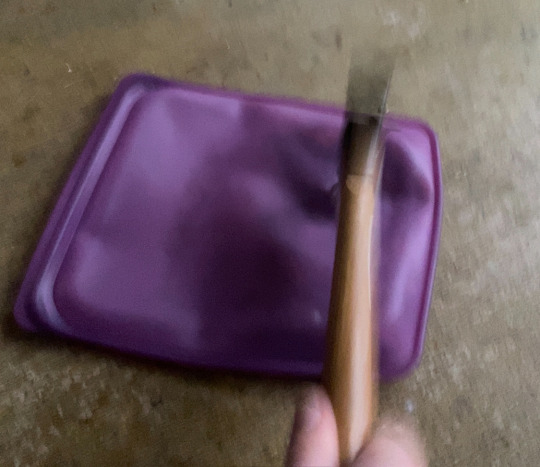


It has been a party and also the least arthritis friendly experience if i didnt have carpal tunnel already i def do now
later ill post how it turns out and link the article im using!
#Oak galls#foraging#traditional art#artists on tumblr#if i didnt do something creative today i was going to explode#Whenever the horrors come for you just make ink about it#Ink#natural ink#botany
10 notes
·
View notes
Text

hi my life is a disaster.
#natural fibers#nettle#I’m losing my mind guys.#cyanoupdates#also pictured: grape seeds ibuprofen my endless todo list my homemade#*my homemade pestle that was previously used to smash oak galls#white rabbit candy in a new flavor that I’ve never seen before#idk man. life’s a mess#oh. and some corn husk cordage#the fiber rabbit hole goes all the way down folks. sad to say
17 notes
·
View notes
Text
Okay, so this is really cool! You have this phenomenon where some plants grow edible appendages to their seeds to entice ants to carry them underground where they can safely sprout. And then you have wasps which lay their eggs on the leaves, stems, and other parts of plants and trigger the growth of galls (swellings) which both feed and protect the wasp larvae until they reach maturity.
The boy who was watching the ants noticed they were taking wasp galls underground, too. Further exploration found that the wasp larvae were unharmed inside the galls; the only thing the ants had eaten were edible appendages similar to those on the seeds they collected. The wasp larvae stayed safe inside the ant nest, feeding on their galls, until it was time to emerge and head back out to the surface.
So it turns out that the edible portions of the galls have the same sorts of fatty acids as the edible parts of the seeds. And those fatty acids are also found in dead insects. Scientists think that the wasps evolved a way to make the galls they created mimic the edible portions of the seeds to get the ants to collect the galls. This isn't the only example of wasps making use of ants as caretakers for their young, but it's a really fascinating example thereof--especially if you consider ants evolved from wasps at least 100 million years ago.
#wasps#ants#plants#galls#oak galls#insects#invertebrates#Hymenoptera#ecology#bugs#animals#wildlife#nature#trees#entomology#science#natural science#evolution#animal behavior
12K notes
·
View notes
Text


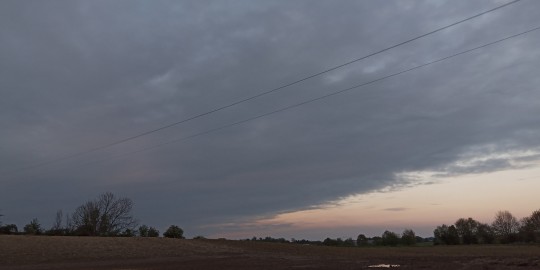
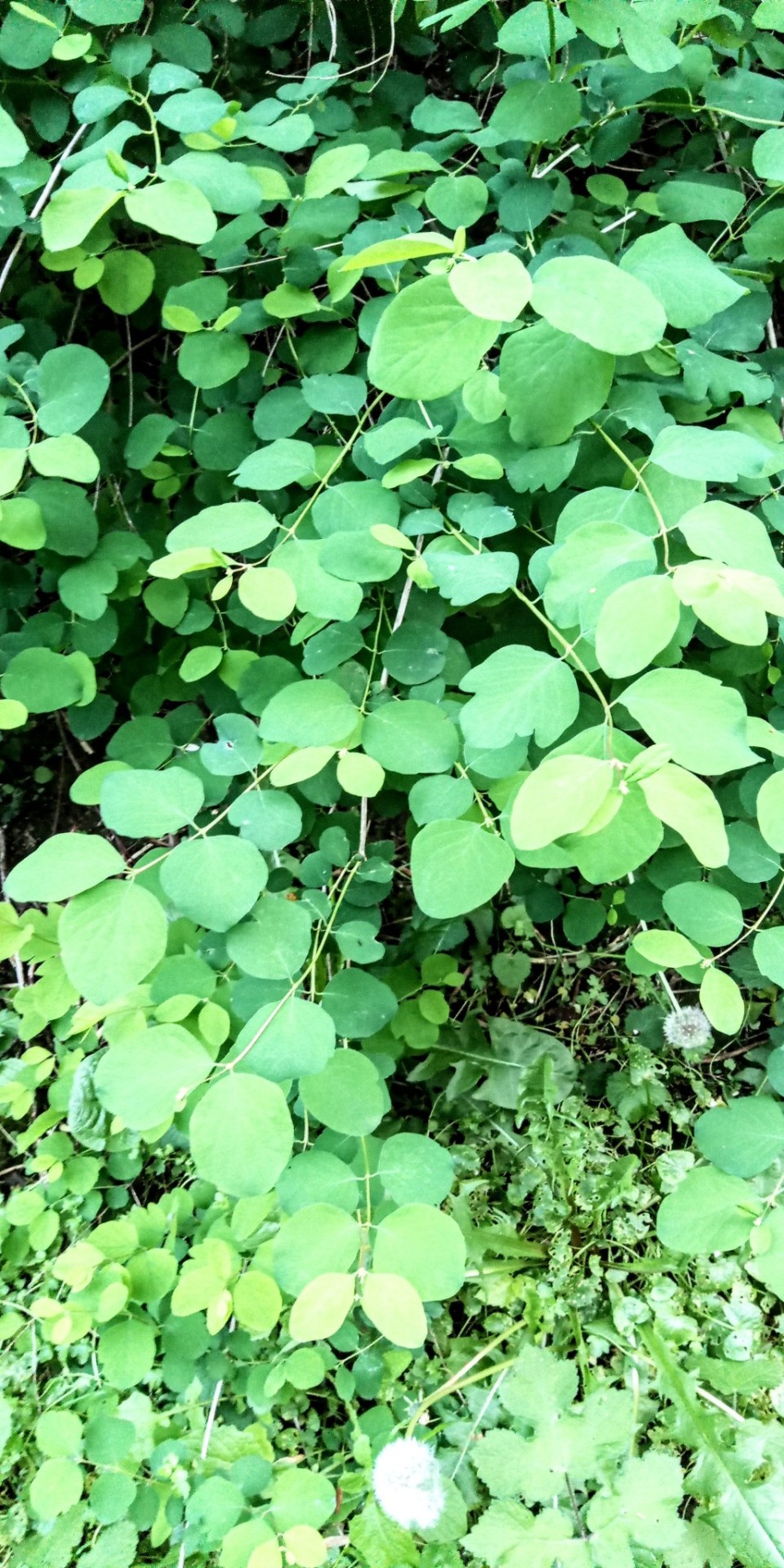



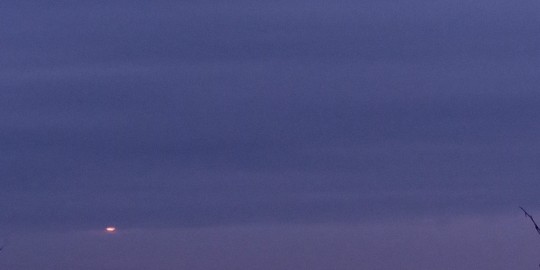


#my pictures#april#seasonal#full moon#oak apple#insects#sky photoset#sky photography#landscape photography#landscapes#sky pictures#plant pictures#evening sky#sunset#clouds#wasp#herb robert#gall nuts#hawthorn blossoms#of night and light and half light
3 notes
·
View notes
Text

I drew Kyle Broflovski as a digital drawing starter:3
#kyle broflovski#south park#cryle#style#k2#comfort character#kinnie#:3#x3#xd#:d#:p#<3#yay#oak galls#coems#^^#> <
11 notes
·
View notes
Text

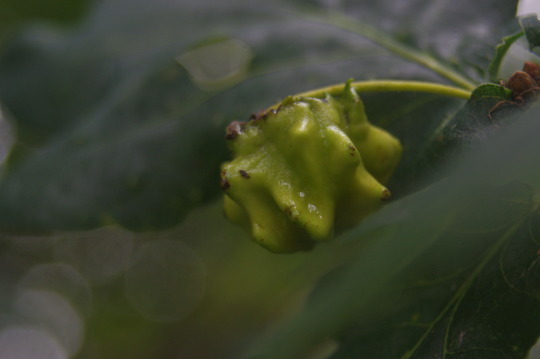
August 2021
#cottagecore#dark cottagecore#forestcore#rangercore#naturecore#trees#insect#wasp#galls#gall wasp#oak
8 notes
·
View notes
Text

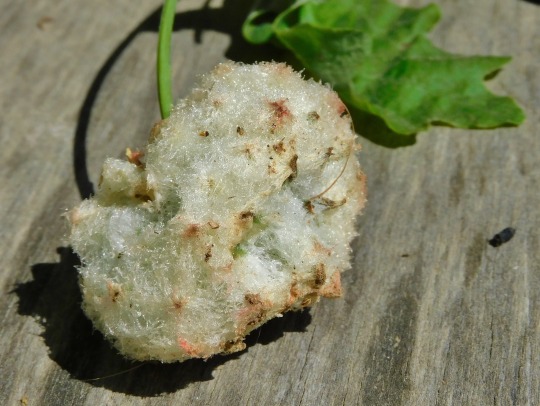

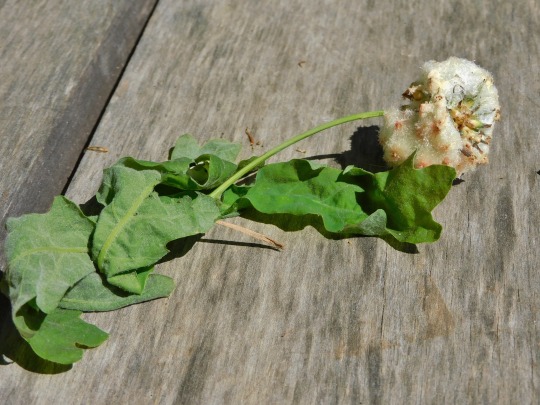

A gall of a Wool Sower Gall Wasp (Callirhytis seminator) on a fallen Oak twig...
#nature#my photography#nature photography#wasp gall#gall#insect eggs#backyard nature#oak tree#insect
3 notes
·
View notes
Text
The nerve! The Gall!
Oak trees have got to be pissed about galls.
Galled if you will.
"I made an apple for a wasp? I'm not even a fruit tree--And it didn't even help me grow any new oak trees? no seeds? Just a wasp house? Why would I do that???
And now some monkeys are mashing it up to make marks on... on OMG. Is that pressed pulped *flesh* ?
No, not that sheep skin one... that other one... was that... dear Edna?"
12 notes
·
View notes